|
The One Sheet Challenge!
Two Person One sheet
skiff...? |
| A couple of folks have contacted me about using my Mini-Sharpie
as a tender, but they want her to carry 2 adults. She looks like a
bigger boat than she is, but she's not. She's one sheet of plywood. I
made her to sail me and my dog or a kid or two. That's all. And I think
she'll do that well. But, it got me thinking. |
NEWS FLASH!
Roger S. launches his "Fat Little Skiff." and she handles
a crew of 328 lbs.
See blow....
|
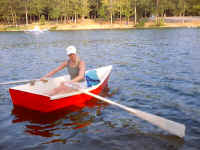
|
Why can't a one sheet dinghy carry two adults?
It's a puzzle really. One I haven't yet solved. It seems doable, but I've never
seen it done. I've fiddled with a pram one sheet that has more capacity, but
it's not as much greater capacity as you'd think.
But it seems like it should be doable. If you consider that a 2 ft wide box with
1 foot sides seven feet long can be made with a sheet of plywood (you'd have to
scarf one transom), and that volume is 14 sq. ft or about 840 lbs of water. So a
6 inch draft would be 420 lbs with 6 inches of freeboard. Make the transoms out
of something else and flare the sides and you get over a 1000 lbs to swamp her.
(or so says Carlson's Hulls program.)
So it seems it could be done or should be able to be done - but in these thought
experiments I'm sitting in a
wooden box without the usual properties you want from a boat. Like rocker and
not plowing her bow or dragging her stern.... A puzzle?
After bouncing this challenge off the boat design group, and getting a
variety of discouraging and encouraging responses, I decided to give it
a go anyway. And it resulted in a new appreciation of the lowly Jonboat. The
first boat I ever had was an eight foot aluminum Jonboat. As I recall it was
a lot like the one I just drew, and now I know why. It requires very little
bend of the sheet material, and yields about maximum capacity for the size.
I began with a box and began to modify her. She has a
pram bow, into a flat run and a slight rise to the stern transom. She's flared
and narrows slightly bow and stern. All this to get her to look and behave
more boat like and less box like. She's 8 ft long, 3 ft wide at the gunnels
and 28" at the chines with 12 1/2" sides.

|
.Granting myself permission to make the transoms out of
solid wood. (Hey, we make our own rules around here!) made the task more
doable. Here is a proposed layout. Since we have to make the rails of
something - I decided to use 1x4 (3/4" x 3 1/2") attached with a
1" rabbet (notching the ply into the rail) which will add 2 1/2"
to the sides. |

|
.Here's as close as I could get it in Hulls. The program
doesn't want to make a dead flat bottom that curves only at the ends but
it's close. |
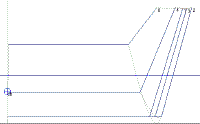
|
.Here are the end views of the transoms and stations. The
waterline is at 4 inches of draft with 336 llbs. displaced. My guess is
the boat will weight between 35 & 40. |

|
.This shows the waterline at 336 lbs displacement. Then
transom is only about an inch under water, so wont suck too terribly. At
230 lbs - more a couple of kids and their stuff range - the transom barely
touches.
With myself, my wife, our dog and the boat we'll weigh about 400 and
the draft will be 4.8". Not too terrible for playing around. A small
stern deck of 1/8" ply wouldn't add much weight and allow you to
lower it into the water by it's bow line, off a boat or dock without
taking any water on board.
|
|
|
This is the first attempt, but I'm sure it wont be the last.
I'll keep you posted! |
|
|
|
|
|
Gavin Atkin's response to this creation was:
"That's no jonboat - it's more like the bows of one attached to
the bows of another... A jonoj, if you like. :-) Or maybe a taobboat.
Call it what you like, it's a cool-looking realisation of what I was
trying to describe in a mail I wrote on this topic the other day. I couldn't then
guess what it's performance would be - I really don't have an idea how it would perform in the water - but it is very burdensome for its size and it
is certainly boat-shaped. Make it vertical sided, and you could call it
Bargemouse, mebbes...
Gav"
|
|
|
Gav,
It's not THAT double ended. At one stage in its
evolution it had a straight run in the sides and bottom, back to a larger transom that was 90
degrees to the bottom. Sort of like some Jim M. boats are. It actually
gave it more capacity and technically would handle a motor better... but I
couldn't imagine anyone trying to get this boat planing... Hmmmm... I just
remembered I put a four horse kicker on my 8 ft Johnboat when I was 10
years old and that boat definietly planned... big time. A ten year old don't
weigh
much.
Ah the good ol' days.... what was my mother thinking! What am I thinking?
One of those cute little 2.5 horse Tohatsus maybe?
David
|

|
So I went back to that iteration of the design to see what
it might have to offer. |
|
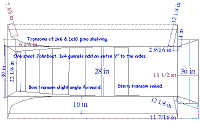
|
Here's that older layout. No rise to the stern transom. No
tuck either... straight run midships aft.
I even sketched the extended 1x4 gunnels in if you want to print this
on file folder stock and fold it into a paper model. |
|

|
Here's the displacement. Interestingly at 397 lbs the draft
is 4.6" Gained 2 tenths of an inch from the design above. And the
bottom of the transom is now 4.6" below the waterline instead of a
little over an inch of the one above. |
| What does all this translate to? A one sheet boat can be
made to hold two adults. The first design was more rowable and sailable,
while this one would be better to motor. I mean gas motor though. The
first will be better for an electric motor being more hydrodynamic. This
one will have more surface area aft to allow it to plane if you have
adequate power to weight ratio. |
Lew Clayman entered his own sketch brainstorm into the explorationl.
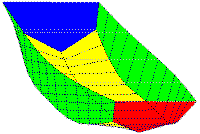 |
"I just uploaded a Mouse-inspired hull and 3
screenshots (one of which I colored
in, whee!). As shown it displaces 300lbs. It's a v-bottom,
curvy-sided and
curvy-sheered little box, 7' long. OSB3 means "one sheet box,
version 3."
Lew Clayman
Here's a 3D view of Lew's OSB3. |
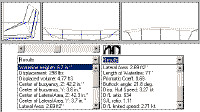 |
Here are the three views in Carlson's Hulls program. |
 |
If you look at the nesting you'll see that the ply is not
used efficiently at
all, and without doubt could be improved markedly. But she'll take
an adult
and a kid, and some of the scrap can probably make a leeboard and a
rudder.
What it does show, maybe, is that way more is possible from one sheet than
we're used to demanding.
Enjoy it as a concept, I don't consider it "ready-to-build" yet. |
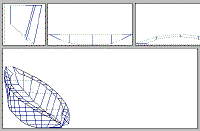 |
Lew also haw a one sheet canoe or kayak like boat he's
playing with.
"It's an open-cockpit two-person kayak, called CNU, ...
The gimmick is that you are to cut the "deck" piece and from
inside
that piece of ply you are to cut the "keel" piece - really a
flat bottom...
Rated to 340# Disp, 300 for the crew and a nominal 40 for the hull,
she'll be good for fooling around in mellow waters. With one
occupant she'll do lots better."
|
| Fat Little Skiff...
by Roger S.
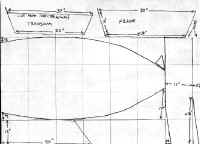

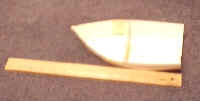
|
"I just uploaded all the skiff I can get out of one
sheet of ply.
She would have a max beam of 43", max width of the floor is 36",
length is 6'9", and 12" sides. She would be a tall, fat
little
boat. I think a 1X10X12 would finish her off, including transom,
frame, chines and rubrails, and maybe enough for a skeg. I went for as much beam and freeboard as I could
get, and still got 6'9" of boat. The transom and frame may not
be exactly
to scale and my scanner won't pick up but 11" of paper, but it was
drawn to
1 1/2"= 1'. The missing piece is identical to the piece [on the
far right.]
Roger S

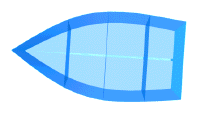
 These are screen shots of the VRML model generataed by Greg Carlson's
Hulls program. Roger, yours is definitely cuter than the pram version. Is
a square bow worth another 50 lbs of capacity?
These are screen shots of the VRML model generataed by Greg Carlson's
Hulls program. Roger, yours is definitely cuter than the pram version. Is
a square bow worth another 50 lbs of capacity?
|
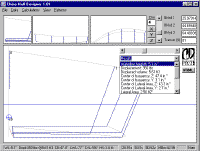 |
Here's a hulls representation I made of Roger's FLS (fat
litttle skiff)
The waterline is at 350 lbs - quite impressive. I like how he pieced
the sides to keep a lot of freeboard. He could still use my extended rails
trick, but he may not need to, she holds a lot as she is. And Roger, that
was maintaining the "flat iron" shape - if you wanted to put a
bow transom in her and make her a pram, she'd have even more capacity!
(400 lbs at 5 inches of draft by my calcs.) Here's an attempt at making
a Hulls file available. I think if you click and select "save target
as" you might get it without your browser trying to open it. Well
see... Osrogers.hul |
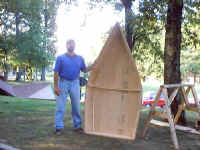

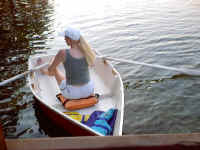
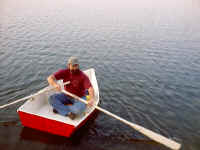
|
July 8, 2002
I posted a picture of the unfinished FLS last night. I intended
to
finish the little boat this weekend, but a stiff breeze was blowing
and the "Summer Breeze" was calling me to the lake. Maybe
I'll get
her to the lake next weekend.
Roger S
August 11, 2002
Here are some pictures of the FLS launch. Most of the
pictures are of my spokes model, Dawn. It was her first experience
in a row boat and she has claimed the little vessel as her own. The
other picture is me, just to show how she sits with 208lbs in her.
I was very pleased with her performance. She successfully carried
two people at 328lbs across a small lake, though admittedly she did
row much easier with one. She tracked well with one person and
would coast along well enough that one stroke every 5 seconds would
keep her at decent speed.
Roger S
|
  |
Here's FLSPR (Fat Little Skiff Pram) The bow is 26 7/8"
at the top and 18" at the bottom. (made from 1x12) |

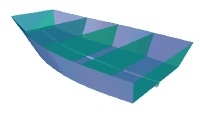 |
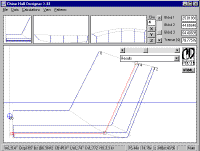
This shows her displacing 397 lbs at 5.4" of draft. |
If you like to play with Hull Designer files, here it is.
Osflspr4.hul again, try "save
target as"
|
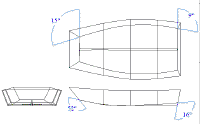 |
Here are the 3 views from the Hulls DXF file. |
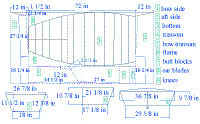 |
Here's a sample layout. I altered the bow transom from the
hull file to get it to fit a 1x12 board.
I like that the sides are high enough that you don't have to extend
them with the rails, so they could be 5/8" x 3/4" - gunnel and
inwales. There's plenty of wood left over in the layout for knees,
breasthooks butt blocks etc. If the laminated rails could be made stiff
enough the frame could be temporary. |
| Since building the prototype, I
would make the longest portion of the sides have grain running
longitudinally. New layout will be posted later. |
This layout gets the side
skarff up where the mast partner will be might. I've also made the bow
transom rake a good bit to avoid "plowing" when loaded. I've
added some bow rocker which keeps the bow transom at 11.5" tall. |
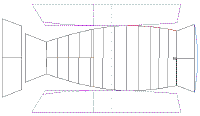 |
Here's a layout that can be printed on card stock or file
folder and folded into a 3D model. I show both straight lines for the bow
chine and also the rocker curve. |
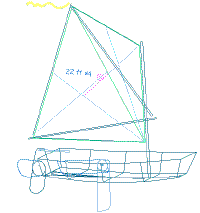 |
Here are a possible of possible rigs, the sprit rig to the
left, and a standing lug to the right. |
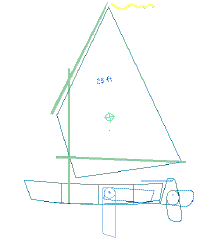 |
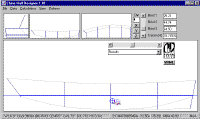 |
Rocker!
It looks like I'm rediscovering the advantages of rocker now. This 7th
version has enough rocker to have the stem and transom touch at 350 lbs
disp. and at 400 lbs the draft is 6". This hull shape with the
rabbeted 1x2 for the rails would yield equivalent freeboard and much
better performance. |
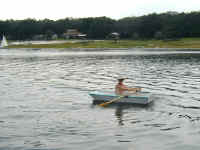
|
I built the "fat little pram" over the July 4th
holiday. (Julie calls her "Pram I Am") With a primer coat, no
frame or knees - she weighs 30 lbs.
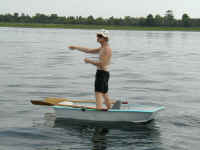 I'm "air fishing" to test stability - I wouldn't run around in
her, but standing is pretty easy.
I'm "air fishing" to test stability - I wouldn't run around in
her, but standing is pretty easy.
|
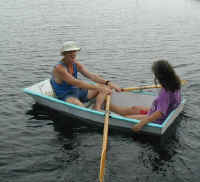 |
Total weight in these photos is 385
lbs. I'm guessing we still had about 5" of freeboard. I had to narrow
the frame to allow for external chine logs. Stitch and glue could have
retained a bit more volume.
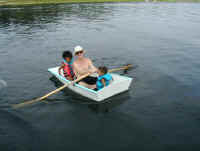
|
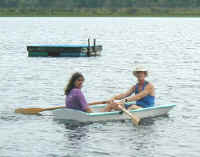 |
For more pictures of her with a range of crew and such go here.
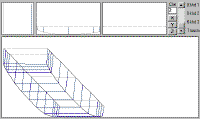 |
Gavin Atkin sent me a hull file of his Bargemouse"
"Going at it a different way, I modelled a straight-sided
punt with a largely straight
bottom with sharp-ish bends in the ends. I got it up to 350lbs with some
tweaking, but I can't say I'm
particularly happy with the result. It'd function as a boat, sure enough,
particularly when light, but it would
also be ugly, inefficient and stodgy when loaded. And that's just the list of
faults I can guess at now..."
|
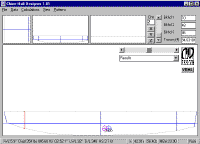 |
This is very near a barge version of the theoretical 2' x 1'
x 7' box that started me thinking about this. With solid wood transoms Gav
has it 8' long. 23" wide and 12" tall.
At 354 lbs her draft is 5.9" right at half her 12" vertical
sides. |
|
I was bragging on Roger's FLS to Gavin and he shared this
quote he ran across. |
|
"I noticed this in Adlard Coles 'Sailing Days',
published in 1944.
'It was in the month of May, on a fine summer's morning, that we rowed
upstream in the dinghy from Hamble to Zest's moorings near the training
ship Mercury. It was a hard row, for the ebb was beginning to run and the
little boat, only 5ft 6ins long, was deep in the water, loaded with the
weight of two adults and the provisions, water and gear for a week's
cruise. But if the work was heavy our spirits at least were light, for we
were going sailing and the weather seemed set fair.'
FIVE FOOT SIX INCHES!?! It's amazing they ever reached their yacht!"
Gav
*****************************
Ok Gavin, maybe we are re-inventing the wheel as usual, and maybe we do
have a ways to go yet, but....
- of course there's no mention of the depth or beam of the
"little boat." (Wasn't one of those deep keel ocean crossing
stunt boats under 6 ft?) And there probably wasn't a single scrap of
plywood in her! (It had been invented but wasn't widely used in boat
building yet was it? I might be confused on that.) Crazy how available
materials effects the design process, eh?
|
| Steve's Mini-Max Punt
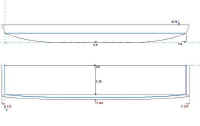
|
Here's my entry to the OSS Challenge.
Waterline is at 400 lbs, just kissing the bow and
stern transoms. Transoms are at 20 deg, and the sides are at 15 deg.
It would use 1 sheet of 1/4" ply and a 1 x 10 for the transoms and
seats. Sides are 9" high, chine width is 30" and waterline is at
4.8". Definitely a still water, no wake area boat, but still useable.
Bottom is 30" from stem to stern, with a center shear beam of
35-36".
Overall weight in the 35-45 lb area, depending on materials and
methods. Single double paddle, double single paddle, oars or electric
trolling motor for propulsion. Call it a Mini-Max Punt if a name is
needed.
Steve
|
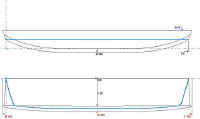 |
Did up a Vee bottom version for those so inclined. Slightly
narrower
than the flat bottom version, it should still kiss the transoms at
400lbs gross. Still running 35-45 lbs with 1/4" ply and should be an
easy build for less than $100.00. Pics under Lewisboats. [in photo section
of the Yahoo Boat Design Group]
|
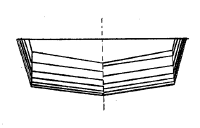 |
I was thinking of using 1x6" stock for the rails, just
for that added
bit of style (LoL!) Noodles around the edge and maybe at the
waterline would help too.
Steve
|
Two more from Steve:
Roamer & Roamer V.
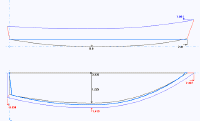
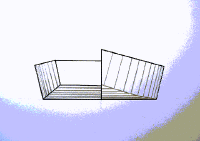
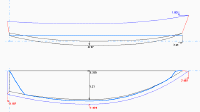
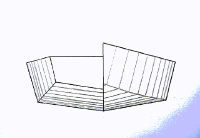
|
Been dabbling most of the evening with a pair of One Sheet Skiffs, a
flat bottom and its V bottom brother. Both can be made with one sheet
of ply(with very little to spare), but transoms and seats need to be
1x10s. Waterlines on both are at 200 lbs, with transoms just touching
the water. Boats should be in the 30-40lb range, with 1/4" and pine
(less if 1/4" scap is used for the transom) and stitch and glue
construction. Sail might be a possibility, with the waterline at just
under 7 1/4 ft, and a beam at draft of about 31". Beam at chine is
about 29" and beam at ply sheer is 34". Freeboard is around
6" at the
lowest point, at 200lbs gross weight. Assistance from substantial
rail material might be in order (1x3-4s?) to safely use at 250-260
lbs. Performance would probably suffer from the extra weight though.
A skeg (not shown) would also be needed for proper tracking.
I was thinking of Gavin's mention of "the best hull" in an
earlier
post. This is an just attempt to get a decent performing hull, that
can carry 1 healthy male of somewhat reasonable weight, all out of 1
sheet of plywood (Plus have it look not too bad too). I'm 5'7" and
200lbs right now, so I'm not the best candidate for the weight
allowance, but at a healthier 165-175lbs, I would think it would be a
pretty good performer. It should be perfect for most early to mid
teenage boys and most women though.
Steve
|
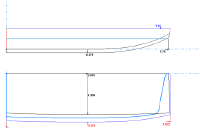 |
Here is a boat that uses 1 entire sheet of ply for the
bottom and the
rest is 1x12". The sides, transoms and seats can be cut from about 36
board feet of 1x12" and 4 board feet of 1x8". The water line is
950
lbs. This is the max displacement I can get from one sheet of ply and
still call it a boat and not a box. The boat has a 5 deg deadrise,
and has 10 deg of front transom inclination. The rear transom is
plumb. To put rocker in it reduces the max cap to about 770lbs, and I
come out with a modified, V-bottom Brick.
Steve.
Check out Steve's web site.... Lewisboatworks
|
Single Sheet Pleasure Barge
Peter Vanderwaart
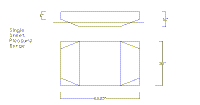
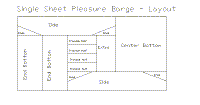
|
I don't usually take much notice of the discussions of
single sheet boats and the like. My interests are in larger craft. Not
that I mind; single sheet boats
and the like are what this forum is for. However, my mind did wander
the other day into this area, and I have brought forth a design. Now,
if I have reinvented the wheel, as seems likely, you can tell me. I
won't get huffy.
This 5' 3 1/4" vessel is the Single Sheet Pleasure Barge. Her shape
is similar to the barges used around here for hauling gravel and iron
scrap. She's an angular creature built around two frames. I suggest
a 2x2 (or doubled 1x2)
across the bottom since it's more or less a butt between bottom
pieces. It's also necessary to butt the transoms in the middle. The
triangular pieces in the ply layout can be used for knees at the
gunwale level for reinforcement, a la Brick. The piece
labeled 'extra' can be used for the transom butts, as well as gussets
for the frames.
If one insisted, I suppose he could smooth out the bottom profile
with only a little loss of capacity. But a smooth butt joint would
take more ply than I have left over. At this tiny size, I really
don't think the hydrodynamic difference between this and Tortoise
really amounts to much.
A boat like this could have many uses. For example, with wheels and a
handle, it would make a hell of a lawn cart. Without them, perhaps a
cold frame.
Displacement is about 400 lbs with the lower edge of the transoms at water
level.
Peter
|
| Simplicity Boats Home Page |
|
|
|
|
|
|
|
|















































